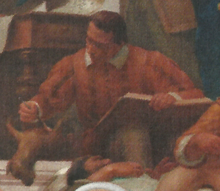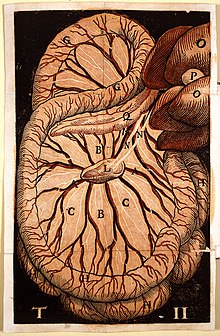Gaspare Aselli
Gaspare Aselli | |
|---|---|
 Portrait of Gaspare Aselli by Cesare Bassano | |
| Born | 1581 |
| Died | 9 September 1625 (aged 43–44) |
| Nationality | Italian |
| Alma mater | University of Pavia |
| Occupation(s) | Physician, anatomist, surgeon, university teacher |
| Known for | Discovery of the lacteal vessels of the lymphatic system |
| Parent | Benedetto Aselli |
| Scientific career | |
| Institutions | University of Pavia |
Gaspare Aselli (or Asellio) (c. 1581 – 9 September 1625)[1] was an Italian physician noted for the discovery of the lacteal vessels of the lymphatic system. Aselli discovered (or rediscovered) the chylous vessels, and studied systematically the significance of these vascular structures.
Life[edit]
Gaspare Aselli was born in Cremona of a wealthy patrician family. He attended the University of Pavia, where he obtained degrees in medicine, surgery and philosophy. He continued his studies in Milan, where he practiced medicine with great distinction. The Milanese Senate named him an honorary citizen “by virtue of his superlative qualities as doctor and scientist”.[2] In 1612 he was appointed Head Surgeon of the Spanish Armada in Italy. He became professor of anatomy and surgery at the University of Pavia shortly before his death in 1625 at the age of 44. He is buried in Milan, in the church of San Pietro Celestino, near Porta Venezia.
Contributions[edit]

Aselli is regarded as the discoverer of the lacteals, or the set of vessels which absorb or suck up the nutritious portion of the food of animals, i.e., the chyle from the upper part of the intestinal tube, in order to convey it to the heart and lungs, so that it may become incorporated in the circulating fluid or blood. On 23 July 1622, during a vivisection performed on a dog, he saw these vessels, and from the white color of the fluid they contained, from the milk-like character of which is derived the name of lacteal,[3] distinguished them from the other vessels, and demonstrated them in his lectures. Aselli observed that the vessels were filled only after digestion, at other times being scarcely visible. He traced them to a group mesenteric glands still known as “Aselli's gland” or “pancreas Aselli”, and believed that they passed on into the liver, thus failing to trace their true ending; it was not until Jean Pecquet's discovery of the thoracic duct and its continuity with the lacteal vessels that the process of absorption was clearly established.[4] He recognised the presence of valves in these vessels and showed that they prevented a backward flow.[5]
The lacteals were termed the fourth kind of vessels (the other three being the artery, vein and nerve, which was then believed to be a type of vessel), and disproved Galen's assertion that chyle was carried by the veins.[6]
By highlighting the existence of chyliferous vessels and lymphatic circulation, Aselli’s discovery greatly contributed to debunking Galen's generally accepted theory that the liver was the source of the blood – a belief that was definitely disproved by William Harvey in his seminal work De Motu Cordis.
De lactibus sive Lacteis venis[edit]

Aselli drew up, but never published, an account of his discovery. His description of the lacteals, De lactibus sive Lacteis venis, was published after his death, in 1627 at Milan, thanks to the liberality of Fabri de Peiresc.[7] In its use of polychrome woodcut-print to more accurately distinguish the different types of vessels depicted (the arteries and blood vessels are represented in red, the lacteal channels in black, etc.), De lactibus was the first publication to use colored illustrations in the interest of scientific accuracy.[1][8] The striking woodcuts, which appear in this edition only, have been attributed to either Cesare Bassano or to his associate Domenico Falcini.[1] Aselli's work was later reprinted several times all over Europe: Basel (1628), Leiden (1640, and again 1641), Amsterdam (1645). It was included in the 1645 Opera omnia of the Padua anatomist Adriaan van den Spiegel.
Shortly before De motu cordis (1628) appeared, Aselli anticipated William Harvey's monumental discovery of the circulation of the blood. In his De lacteis, indeed, he wrote these remarkable words about the circulation:
Perhaps it would not be absurd to suppose that the blood brought to the lung by the vena arteriosa (i.e. the pulmonary artery), mingled with the air attenuated by the lung and returned to the left ventricle through the arteria venosa (pulmonary vein). Perhaps it is not necessary to imagine the passages that Galen supposed to exist in the interventricular septum, which could not have any use.-De lactibus, 1627, p. 16.[9]
Together with William Harvey's discovery of the circulation of blood, Aselli's discovery of the lacteal vessels ranks among most important physiological discoveries of the XVII century.[10][11] The experimentation on living animals, and particularly the vivisection used by Gaspare Aselli provided the basis for much of the subsequent investigation of the human physiology.[12]
Works[edit]
- De lactibus, sive lacteis venis, quarto vasorum mesaraicorum genere novo invento. Mediolani: Apud Jo Baptistam Bidellium. 1627.
- De lactibus, sive lacteis venis. Leiden: Johannes Maire. 1640.
References[edit]
Notes
- ^ a b c Premuda 1957.
- ^ Capparoni 1933, p. 299.
- ^ «Ego vasa haec, aut lacteas, sive albas venas, aut lactes etiam appellare soleo...» (De lactibus, sive lacteis venis, p. 23); «Non lac ipsum magis simile lacti est quam liquor qui in illis cernitur.» (ibid., p. 26).
- ^ Stöhr, Philipp (1913). Stoehr's histology. P. Blakiston. p. 182.
- ^ Müller, KH.G. (1995). Technik der Darstellung des Lymphsystems. In: Müller, KH.G., Kaiserling, E. (eds) Lymphgefässsystem Lymphatisches Gewebe. Klinische Radiologie. Springer, Berlin, Heidelberg. p. 17. doi:10.1007/978-3-642-78715-7_4
- ^ Flourens, Jean Pierre (1859). "Chapter 3: Aselli, Pecquet, Rudbeck, Bartholin". A History of the Discovery of the Circulation of the Blood. Rickey, Mallory & company. pp. 67–99. Retrieved 2008-07-11.
- ^ Stirling & Banting 1902.
- ^ Choulant, Johann Ludwig (1920). History and Bibliography of Anatomic Illustration. Translated by Mortimer Frank. University of Chicago Press. pp. 240–1.
- ^ Castiglioni, Arturo (1958). A History of Medicine. Alfred A. Knopf. p. 521.
- ^ Chapman, Allan (2016). Physicians, Plagues and Progress. The History of Western Medicine from Antiquity to Antibiotics. Lion Hudson. pp. 218–9. ISBN 9780745970400.
- ^ Guerrini, Anita (2013). "Experiments, Causation, and the Uses of Vivisection in the First Half of the Seventeenth Century". Journal of the History of Biology. 46 (2): 227–254. doi:10.1007/s10739-012-9319-7. JSTOR 42628772. PMID 22492092. S2CID 2866315.
- ^ Park & Riva 2022.
Bibliography
- Manget, Jean-Jacques (1731). Bibliotheca scriptorum medicorum. Vol. I. Geneva. p. 185.
- Argelati, Filippo (1755). Bibliotheca scriptorum Mediolanensium. Vol. II. Milan. p. 2058.
- Stirling, William; Banting, Frederick Grant (1902). Some apostles of physiology: being an account of their lives and labours, labours that have contributed to the advancement of the healing. p. p. 13.
- Boruttau, Heinrich Johannes (1903). "Geschichte der Physiologie in ihrer Anwendung auf die Medizin bis zum Ende des neunzehnten Jahrhunderts". Handbuch der Geschichte der Medizin. II. Jena: 335–336.
- Zoja, Giovanni (1875). Cenno sulla vita di Gaspare Aselli anatomico del secolo XVII. Pavia.
{{cite book}}: CS1 maint: location missing publisher (link) - Ducceschi, Virgilio (1922). "I manoscritti di Gaspare Aselli". Archivio di Storia della Scienza. III: 125–134.
- Capparoni, Pietro (1928). Profili bio-bibliografici di medici e naturalisti celebri italiani dal sec. XV al sec. XVIII. Vol. II. Rome. pp. 70–72.
{{cite book}}: CS1 maint: location missing publisher (link) - Capparoni, Pietro (1933). "Il manoscritto di Gaspare Aselli sulla scoperta dei vasi chiliferi". Bollettino dell'Istituto Storico Italiano dell'Arte Sanitaria. XIII: 299–313.
- Fulton, John Farquhar (1938). "The Early History of the Lymphatics". Bulletin of the Hennepin County Medical Society. 9: 5.
- Premuda, Loris (1957). Storia dell'iconografia anatomica. Milan. pp. 163–164.
{{cite book}}: CS1 maint: location missing publisher (link) - Hovnanian, August P. (1966). "Study of the Thoracico-abdominal Lymphatic System". Archives of Surgery. 93 (3): 371–376. doi:10.1001/archsurg.1966.01330030001001. PMID 4287826.
- Premuda, Loris (1970). "Aselli, Gaspare". Dictionary of Scientific Biography. Vol. 1. New York: Charles Scribner's Sons. pp. 315–316. ISBN 0-684-10114-9.
- Park, Jiho; Riva, Michele A. (2022). "Gaspare Aselli (1581-1625) and Lacteis Venis: Four Centuries From the Discovery of Lymphatic System". The American Surgeon. 89 (6): 2325–2328. doi:10.1177/00031348221096573. PMID 35469431. S2CID 248389369.
External links[edit]
- Premuda, Loris (1962). "Aselli, Gaspare". Dizionario Biografico degli Italiani, Volume 4: Arconati–Bacaredda (in Italian). Rome: Istituto dell'Enciclopedia Italiana. ISBN 978-8-81200032-6.
- Gaspare Aselli entry (in Italian) by Gaetano Jappelli in the Enciclopedia italiana, 1929
- Works by Gaspare Aselli at Open Library
